The Kidney Stone Extraction Balloon Market is estimated to be valued at USD 544.2 million in 2025 and is projected to reach USD 1,021.5 million by 2035, registering a compound annual growth rate (CAGR) of 6.5% over the forecast period.

The kidney stone extraction balloon market is witnessing steady growth as minimally invasive urological procedures become the preferred clinical approach for managing nephrolithiasis. Rising incidence of kidney stones globally, driven by dietary habits, aging populations, and sedentary lifestyles, is leading to increased procedural volumes in both developed and emerging markets.
Technological advancements in balloon materials and catheter compatibility have improved procedural efficiency and patient outcomes. Hospitals and specialty centers are prioritizing equipment that ensures greater navigability, controlled inflation, and high tensile strength, reducing the risk of complications.
In parallel, the shift toward disposable, single-use devices is being accelerated by infection control protocols and operational streamlining. Market players are focusing on product differentiation through enhanced balloon designs and material integration to support precision extraction. Future growth is expected to be fueled by rising healthcare infrastructure investments, physician training in endourology, and continued demand for patient-specific, anatomy-adaptive devices.
The market is segmented by Type, Filler, and End User and region. By Type, the market is divided into Nylon, Silicone, and Other. In terms of Filler, the market is classified into Liquid and Air. Based on End User, the market is segmented into Hospitals, Ambulatory Surgical Centers, and Dialysis Clinics. Regionally, the market is classified into North America, Latin America, Western Europe, Eastern Europe, Balkan & Baltic Countries, Russia & Belarus, Central Asia, East Asia, South Asia & Pacific, and the Middle East & Africa.
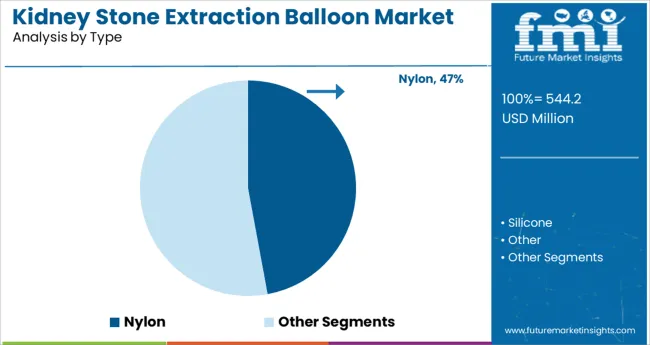
The nylon subsegment is projected to lead the type category with a 47.1% revenue share in 2025. This dominance is attributed to nylon’s superior tensile strength, elasticity, and resistance to kinking, which are critical for controlled inflation and stone manipulation within the ureter or renal pelvis. Its capacity to withstand high pressure without bursting ensures clinical confidence during extraction procedures.
Nylon balloons also offer precision in placement and retraction, which minimizes mucosal trauma and improves procedural outcomes. Manufacturers have increasingly optimized nylon compositions to enhance balloon integrity while maintaining flexibility, enabling effective navigation through tortuous anatomies.
The combination of strength, biocompatibility, and procedural reliability has reinforced nylon’s status as the material of choice in kidney stone extraction balloon design.
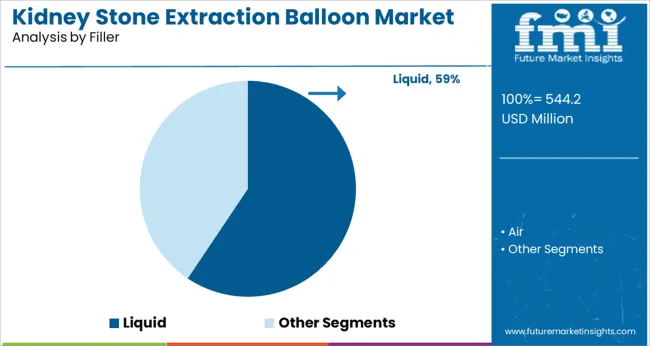
Liquid filler-based kidney stone extraction balloons are expected to capture a 59.4% share of the filler segment in 2025, positioning them as the leading configuration. Their leadership stems from enhanced compliance control, improved visibility under fluoroscopy, and better adaptability to the patient’s anatomy.
Liquid fillers allow for more uniform pressure distribution across the balloon surface, reducing the risk of stone migration and ensuring effective engagement during extraction. Their use has also been associated with fewer complications compared to air-filled alternatives, particularly in delicate ureteroscopic procedures.
Additionally, liquid-filled balloons enable real-time inflation feedback, which enhances surgeon precision and patient safety. These clinical advantages, combined with increasing surgeon preference and favorable procedural outcomes, have driven the widespread adoption of liquid filler configurations in both routine and complex stone extraction cases.

Hospitals are anticipated to contribute 52.8% of total revenue in 2025 within the end user category, making them the dominant channel for kidney stone extraction balloon usage. This prominence is driven by the high procedural volume of urological interventions performed in hospital settings, which are equipped with advanced endoscopic systems and trained surgical teams.
Hospitals benefit from established procurement processes, sterile environments, and post-operative care capabilities that support the use of disposable balloon catheters in a controlled clinical setting. Moreover, the availability of emergency urology departments and access to multispecialty support make hospitals the preferred setting for both elective and urgent stone removal procedures.
Increasing adoption of minimally invasive techniques, combined with institutional investments in specialized urology equipment and adherence to infection prevention standards, have solidified hospital dominance in the end user segment.
The growing prevalence of kidney stone diseases is anticipated to be the key factor responsible for market growth during the forecast period. As per the European Association of Urology and National Kidney Foundation 2020, in countries with a high standard of life such as the USA, Canada, and Sweden, the disease is prevalent in more than 10% of the population.
Increasing adoption of minimally invasive stone removal procedures is another factor that is projected to boost market growth during the forecast period. As per Advances in Chronic Kidney Diseases, in the United States, minimally invasive treatments have been adopted primarily for lithotripsy, percutaneous nephrolithotomy, and ureteroscopy lithotripsy. Changing market dynamics are likely to augment the market size in the coming time.
The major limitation associated with balloon dilation is a more limited size of the papillary opening, which may control the size of the stone that can be extracted using the balloon or a basket catheter. Stones that measure more than 8 mm demand mechanical lithotripsy to allow transpupillary extraction.
Other factors affecting the market growth include the risk of developing urinary tract infection, and injury to the ureter during the procedure, among others. Also, a lack of expertise and a dearth of efficient healthcare infrastructure can limit and impede the expansion of the market during the forecast period.
However, ongoing Research and Development for new techniques and devices in stone disease are anticipated to offer significant opportunities to the market during the forecast period.
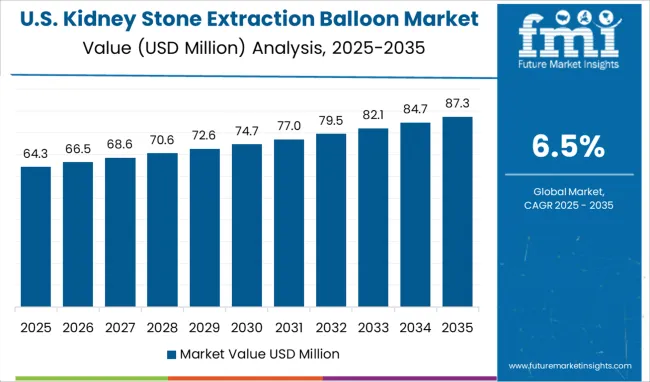
According to the analysis, the global kidney stone extraction market is anticipated to be dominated by North America. In 2025, the region is expected to secure about 32% of the total global revenue.
The domination of the region can be attributed to the increasing prevalence of kidney stones. The market in the region is progressing owing to the presence of favorable reimbursement policies. Also, rising awareness among the patient population about novel methods for stone disease treatment is likely to augment the market size in the coming time.
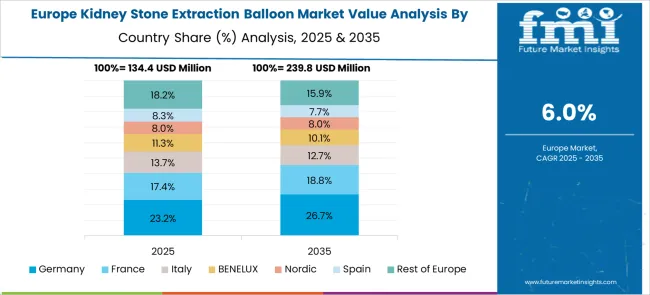
As per the analysis, Europe is projected to be the second-largest kidney stone extraction balloon market during the forecast period. In 2025, Europe is likely to claim 28% of the total market revenue.
The growth of the region can be attributed to the increasing number of kidney stone cases in Europe. Further, higher acceptance of the technologically developed product, increasing healthcare expenses, and developments made by players in the region. In 2020, Dornier MedTech launched an OptiVision technology for its product Dornier Delta III. It is the first image post-processing software that was designed to enhance stone treatment outcomes.
According to the analysis, Asia-Pacific is projected to be the most lucrative market during the forecast period. The growth of the market can be attributed to the presence of developing countries. Increasing awareness about medical devices and the presence of a large patient pool is projected to benefit the regional market.
According to National Center for Biotechnology Information, 12% of Indians are expected to have urinary stones and 50% of them are likely to end up with the loss of kidney functions. Expanding geriatric population affected with kidney stones in Asia-Pacific is anticipated to support the kidney stone extraction balloon market in the forthcoming period.
Players such as Klotho Therapeutics, Invizius, Chinook Therapeutics, Oxalo Therapeutics, Kantum Bio, Monogram Health, Strive Health, pulse data, and ProKidney, are some of the emerging entities in the global kidney stone extraction balloon market.
Players in the market are raising funds which will strengthen the market in the coming time. For instance, a healthcare startup, pulseData raised USD 16.5 Million to help lower the costs to treat kidney diseases. Such factors are anticipated to boost the startup market growth in the coming time.
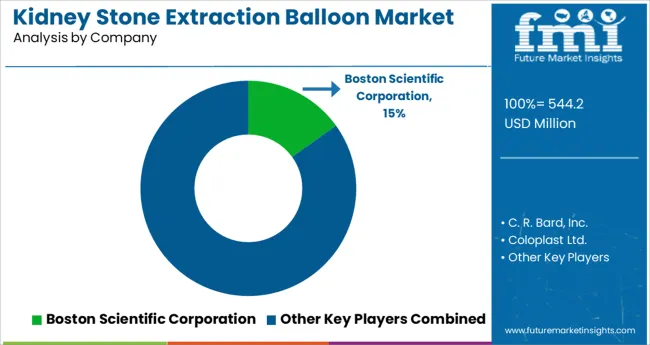
Key players in the global kidney stone extraction balloon market include C. R. Bard, Inc., Boston Scientific Corporation, Coloplast Ltd., iVascular SLU, Cook Medical, Inc., Med Pro Medical B.V., Teleflex Incorporated, NuAngle, and many others.
Recent Development:
| Report Attribute | Details |
|---|---|
| Growth Rate (2025 to 2035) | 6.5% |
| Market Value in 2025 | USD 544.2 million |
| Market Value in 2035 | USD 1,021.5 million |
| Base Year for Estimation | 2024 |
| Historical Data | 2020 to 2024 |
| Forecast Period | 2025 to 2035 |
| Quantitative Units | USD Million for Value |
| Report Coverage | Revenue Forecast, Volume Forecast, Company Ranking, Competitive Landscape, Growth Factors, Trends, and Pricing Analysis |
| Segments Covered | Type, Filler, End User, Region |
| Regions Covered | North America; Latin America; Europe; Asia Pacific; Middle East & Africa |
| Key Countries Profiled | United States of America, Canada, Argentina, Brazil, Mexico, Germany, United Kingdom, France, Spain, Italy, Nordic Countries, Poland, Russia, Australia & New Zealand, China, India, ASIAN, GCC Countries, North Africa, South Africa |
| Key Companies Profiled |
C. R. Bard, Inc.; Boston Scientific Corporation; Coloplast Ltd.; iVascular SLU; Cook Medical, Inc.; Med Pro Medical B.V.; Teleflex Incorporated; NuAngle; and many others. |
| Customization Scope | Available upon Request |
The global kidney stone extraction balloon market is estimated to be valued at USD 544.2 million in 2025.
It is projected to reach USD 1,021.5 million by 2035.
The market is expected to grow at a 6.5% CAGR between 2025 and 2035.
The key product types are nylon, silicone and other.
liquid segment is expected to dominate with a 59.4% industry share in 2025.






Our Research Products

The "Full Research Suite" delivers actionable market intel, deep dives on markets or technologies, so clients act faster, cut risk, and unlock growth.

The Leaderboard benchmarks and ranks top vendors, classifying them as Established Leaders, Leading Challengers, or Disruptors & Challengers.

Locates where complements amplify value and substitutes erode it, forecasting net impact by horizon

We deliver granular, decision-grade intel: market sizing, 5-year forecasts, pricing, adoption, usage, revenue, and operational KPIs—plus competitor tracking, regulation, and value chains—across 60 countries broadly.

Spot the shifts before they hit your P&L. We track inflection points, adoption curves, pricing moves, and ecosystem plays to show where demand is heading, why it is changing, and what to do next across high-growth markets and disruptive tech

Real-time reads of user behavior. We track shifting priorities, perceptions of today’s and next-gen services, and provider experience, then pace how fast tech moves from trial to adoption, blending buyer, consumer, and channel inputs with social signals (#WhySwitch, #UX).

Partner with our analyst team to build a custom report designed around your business priorities. From analysing market trends to assessing competitors or crafting bespoke datasets, we tailor insights to your needs.
Supplier Intelligence
Discovery & Profiling
Capacity & Footprint
Performance & Risk
Compliance & Governance
Commercial Readiness
Who Supplies Whom
Scorecards & Shortlists
Playbooks & Docs
Category Intelligence
Definition & Scope
Demand & Use Cases
Cost Drivers
Market Structure
Supply Chain Map
Trade & Policy
Operating Norms
Deliverables
Buyer Intelligence
Account Basics
Spend & Scope
Procurement Model
Vendor Requirements
Terms & Policies
Entry Strategy
Pain Points & Triggers
Outputs
Pricing Analysis
Benchmarks
Trends
Should-Cost
Indexation
Landed Cost
Commercial Terms
Deliverables
Brand Analysis
Positioning & Value Prop
Share & Presence
Customer Evidence
Go-to-Market
Digital & Reputation
Compliance & Trust
KPIs & Gaps
Outputs
Full Research Suite comprises of:
Market outlook & trends analysis
Interviews & case studies
Strategic recommendations
Vendor profiles & capabilities analysis
5-year forecasts
8 regions and 60+ country-level data splits
Market segment data splits
12 months of continuous data updates
DELIVERED AS:
PDF EXCEL ONLINE
Kidney Transplant Market Analysis by Transplant, Age Group, End User, and Region through 2035
Acute Kidney Injury Treatment Market Growth - Trends & Forecast 2025 to 2035
APOL1 Mediated Kidney Disease Market - Demand, Growth & Forecast 2025 to 2035
Late Stage Chronic Kidney Disease Therapeutics Market Size and Share Forecast Outlook 2025 to 2035
ICU-acquired Acute Kidney Treatment Market
Autosomal Dominant Polycystic Kidney Disease Treatment Market Overview - Growth & Forecast 2025 to 2035
Stone Paper Market Size and Share Forecast Outlook 2025 to 2035
Stone Crushing Equipment Market Size and Share Forecast Outlook 2025 to 2035
Stone Processing Machine Market Size and Share Forecast Outlook 2025 to 2035
Stone Analysis Software Market – Trends & Forecast 2025 to 2035
Stone Cutting Saw Blades Market Analysis & Forecast by Blade Type, Blade Diameter, End User, and Region Forecast Through 2035
Examining Stone Paper Market Share & Industry Trends
Destoner Machine Market Trend Analysis Based on Product Type, End-Use, Automation, and Region 2025 to 2035
Gemstone Market Size and Share Forecast Outlook 2025 to 2035
Gemstone Cosmetic Powder Market Analysis - Trends, Growth & Forecast 2025 to 2035
Examining Market Share Trends in the Colored Gemstones Industry
Pancreatic Stone Protein Testing Market Growth - Trends & Forecast 2024 to 2034
Coloured Gemstone Market Analysis - Size, Share, and Forecast 2025 to 2035
India Colored Gemstones Market Size and Share Forecast Outlook 2025 to 2035
Balloon Catheters for Bile Stone Removal Market Size and Share Forecast Outlook 2025 to 2035

Thank you!
You will receive an email from our Business Development Manager. Please be sure to check your SPAM/JUNK folder too.
Chat With
MaRIA